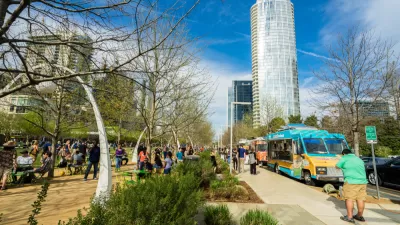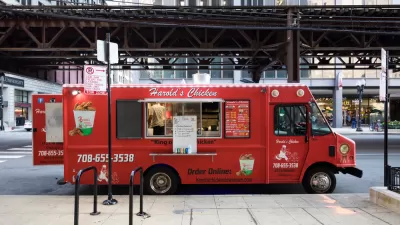In Chicago, food trucks are disappearing and some blame the city’s stepped up enforcement of regulations and fines.

In cities around the U.S., the food truck industry is growing. "In LA County there are currently 2,600 permits for food trucks; Minneapolis, where winters are harsher than they are in Chicago, has 80 to 90 trucks; and Washington, D.C., has 100, according to representatives of those cities' local food truck associations," Julia Thiel reports for the Chicago Reader. Those numbers contrast sharply with those of Chicago, where the city only supports 70 licensed trucks. That number is approximately half what the city had in 2012.
Gabriel Wiesen, president of the Illinois Food Truck Association, argues that the difference between Chicago and those other cities is regulation. In Chicago the laws "…prohibit the trucks from parking within 200 feet of any business that sells food (including convenience stores and pharmacies), and from remaining in the same spot for more than two hours," Thiel reports. These rules have become more difficult to coexist with since a 2012 report in the Sun Times criticized the city for its lax enforcement, which lead to a crackdown.
FULL STORY: Why Chicago’s once-promising food truck scene stalled out

Alabama: Trump Terminates Settlements for Black Communities Harmed By Raw Sewage
Trump deemed the landmark civil rights agreement “illegal DEI and environmental justice policy.”

Study: Maui’s Plan to Convert Vacation Rentals to Long-Term Housing Could Cause Nearly $1 Billion Economic Loss
The plan would reduce visitor accommodation by 25% resulting in 1,900 jobs lost.

Why Should We Subsidize Public Transportation?
Many public transit agencies face financial stress due to rising costs, declining fare revenue, and declining subsidies. Transit advocates must provide a strong business case for increasing public transit funding.

Wind Energy on the Rise Despite Federal Policy Reversal
The Trump administration is revoking federal support for renewable energy, but demand for new projects continues unabated.

Passengers Flock to Caltrain After Electrification
The new electric trains are running faster and more reliably, leading to strong ridership growth on the Bay Area rail system.

Texas Churches Rally Behind ‘Yes in God’s Back Yard’ Legislation
Religious leaders want the state to reduce zoning regulations to streamline leasing church-owned land to housing developers.
Urban Design for Planners 1: Software Tools
This six-course series explores essential urban design concepts using open source software and equips planners with the tools they need to participate fully in the urban design process.
Planning for Universal Design
Learn the tools for implementing Universal Design in planning regulations.
Caltrans
Smith Gee Studio
Institute for Housing and Urban Development Studies (IHS)
City of Grandview
Harvard GSD Executive Education
Toledo-Lucas County Plan Commissions
Salt Lake City
NYU Wagner Graduate School of Public Service




























